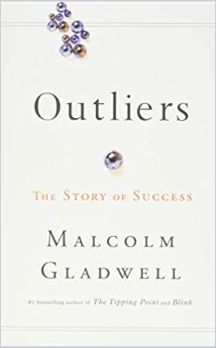Bestseller Malcolm Gladwell explores what makes an outlier and the cultures that outliers outlie from.

10,000 Hours?
Cultural icon Malcolm Gladwell’s bestseller Outliers is his third book, following The Tipping Point and Blink, which established his brand. Outliers concerns cultural patterns and norms, a reasonable subject for Gladwell, since his astonishing success marks him as an outlier himself.
Gladwell demonstrates the tenets of his style. He cites many examples from wide-ranging fields and asserts that the aggregation of those examples defines a principle. He describes behaviors and ideas in the abstract and makes them concrete with memorable illustrative stories.
We’ve seen that extraordinary achievement is less about talent than it is about opportunity.Malcolm Gladwell
Gladwell is the rare incredibly popular author who also enjoys serious literary credibility, as Outliers’ reviews reflect. The New York Times Book Review said, “In the vast world of nonfiction writing, Malcolm Gladwell is as close to a singular talent as exists today…Outliers is a pleasure to read and leaves you mulling over its inventive theories for days afterward.” Entertainment Weekly said, “There are both brilliant yarns and life lessons here: Outliers is riveting science, self-help and entertainment, all in one book.”
Explaining the Inexplicable
One reason Gladwell’s books are runaway bestsellers is that, while easy to read, they make you feel smarter. He provides nuggets of semi-information to spur watercooler or road-trip conversation. He seems able to explain things that remain inexplicable to others, even when his explanations turn out to be merely new ways of describing existing phenomena. Take, for example, his most heralded, remembered and cited assertion in Outliers: the 10,000 Hour Rule.
Pundits, sports commentators and business book authors all cite the 10,000 Hour Rule – that building expertise takes 10,000 hours of practice – as gospel. Many bestsellers cite it as fact. Its ubiquity testifies to Gladwell’s outsized social influence. The 10,000 Rule has become a truism about what success demands.
Gladwell cites a Berlin Academy of Music study that revealed that professional-level classical musicians, from the moment they learned to play until age 20, typically spent more than 30 hours a week practicing, for a total of 10,000 hours in solitary practice. “Merely good students” practiced 8,000 hours; skilled hobbyists practiced 4,000 hours. The study found a direct link between the time a student spent learning and his or her eventual skill level.
Gladwell quotes a neurologist who cites 10,000 hours as the dividing bar. This demonstrates Gladwell’s recurring habit of short-circuiting his own proofs. He doesn’t cite the studies the neurologist calls on; he quotes the neurologist saying the studies exist and prove his point. Who wants to read all those studies? If Gladwell offers a credible expect to provide the right quotes, he knows his readers will be content.
If you work hard enough and assert yourself, and use your mind and imagination, you can shape the world to your desires.Malcolm Gladwell
Instead of telling readers that to be good at something you have to practice – which everyone knows – Gladwell codified that idea in a new-seeming formula, which everyone embraced as an illuminating insight. He pulled off a skillful, memorable, useful and lucrative piece of renaming. Any other author would have had to put in, say, at least 10,000 hours writing bestsellers to accomplish such an elegant move.
Harlan, Kentucky
Gladwell details violent, persistent, 19th-century family feuds in Harlan, Kentucky. Two families, the Howards and the Turners, perpetuated a pattern of killing each other over gambling disputes, then over minor slights, then for revenge and then to avenge the revenge killings.
Gladwell suggests a craggy mountain-born culture of honor as the root cause. Remote highlands in other territories – Sicily, Scotland and Spain’s Basque Country – have spawned similar cultures. Gladwell points out that mountainous areas support herding, not farming. Herdsmen, the author maintains, are ever alert against weather, predators and thieves. Their culture demands instant, violent solutions to threats. Gladwell explains that every herdsman knows other herdsmen will test him, so he must show courage and carry out hair-trigger responses to remain credible.
Oblique Approaches
Gladwell explores whether cultural standards are bred into people or whether people learn culture as he delves into what makes an outlier and what makes a culture from which an outlier outlies.
And here appears Gladwell’s most interesting aspect. When he answers a question directly, as with the 10,000 Hour Rule, you may feel he’s stretching things to make his point. When he approaches questions obliquely, his writing becomes more compelling. You can enjoy his anecdotes and presentation of studies without feeling that a punch line is looming or that he is seeking to prove some grander point.
To build a better world we need to replace the patchwork of lucky breaks and arbitrary advantages that today determine success – the fortunate birth dates and the happy accidents of history – with a society that provides opportunities for all.Malcolm Gladwell
Gladwell convinces readers of his points by merging a wide range of examples and issues and backing them up with studies and statistics. He moves from the heart of a culture to broad-based analytics.
Light Fervor
Gladwell writes with great momentum, no easy feat. His narrative flows most powerfully around ideas that might not stand up to deeper scrutiny. Supposed facts or conclusions you might question somehow surge past in a flood of highly readable prose. As in all of his books, Gladwell presents original insights and banal clichés with the same light fervor, smooth writing and winning sincerity.
If you enjoy Outliers, you’ll relish Gladwell’s Revisionist History podcast and his other bestsellers, including The Tipping Point: How Little Things Can Make a Big Difference; Blink: The Power of Thinking Without Thinking; David & Goliath: Underdogs, Misfits, and the Art of Battling Giants; Talking to Strangers: What We Should Know About People We Don’t Know; The Bomber Mafia: A Dream, a Temptation and the Longest Night of the Second World War; and What the Dog Saw: And Other Adventures. Books with cultural or historical explorations akin to Outliers include Daniel Kahneman’s Thinking, Fast and Slow; Luc Sante’s The Other Paris; and Karen Armstrong’s A Short History of Myth.






